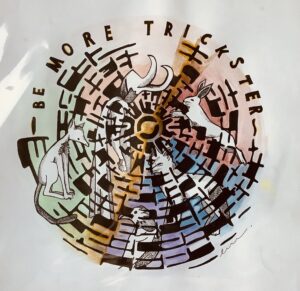Sunday Papers turned 21 last month and so I thought I would look back through some of the themes that have emerged over the years and the 950 or so blogposts. The figure of the trickster has been a restless but pretty constant companion, sometimes provocateur, sometimes guide, sometimes the shadow in the corner when certainty threatens to harden. Journeying back through the archive, I notice how my use of “trickster” has itself been tricky: adapting, morphing, much as the trickster does, to the movements and moods of the times and the evolving questions of church, systems, and cultural renewal. Gathering these together we can see her different guises and learn a few lessons along the way.
Trickster as Disruption: Stirring the Comfortable
In the early days, trickster arrived in my writing as disturbance. Rooted in the stories of Hyde and the many mythic mischief makers, trickster embodied the kind of holy mischief needed to unsettle our ecclesial complacency. I wrote about the discomfort, border-walking, question-posing, edge-dwelling that trickster brings to stagnant communities. Trickster was the strange guest, misunderstood and sometimes unwelcome, who moved the conversation from comfort to confrontation (which probably also reflects my life stage at the time).
There is a necessary place for this sort of energy in organisations and systems facing calcification, when the status quo is defended with greater force than the call of the gospel or the pulse of life. In this stage, trickster is a mirror to stuckness and a living question mark for institutional “wisdom.” Trickster’s value here is not so much in having answers, but in disrupting, and simply tearing open space for something unexpected to begin.
Trickster as Emergence: The Playful Edge of Creativity
As time went on, my engagement with emergence deepened. Trickster moved from being merely an irritant to something generative, a figure not only to challenge boundaries, but to create new ones, or dissolve them long enough for new forms to emerge. The conversations about “emergent church” and “grace spaces” that led to Here Be Dragons revealed the need to dwell not just at the border, but also in the middle, where the boundaries blur and creation teems.
Here, trickster’s play becomes vital. The themes shifted: less about simply sabotaging structure, more about risking improvisation, learning from ambiguity, and allowing the uncomfortable laughter that comes when certainty recedes. Surprisingly, trickster’s lessons in play, parody, and improvisation offered a source of hope and resilience, essential for organisations learning to let go of the need for control and to make space for emergence.
Trickster as Companion: Deep Listening and Systemic Renewal
In more recent years, a subtler, deeper trickster has come to the fore. No longer relegated only to the borders or eruptions of crisis, this trickster appears as a companion in the slow, ongoing renewals of system and spirit. I found myself drawing on trickster stories not just for their disruptive potential, but as a wisdom tradition for co-creative leadership, deep listening, and navigating unpredictable terrain.
Now, trickster is invoked to remind leaders and communities that true transformation happens in liminal space, between the old and not-yet, in stories shared, questions asked, and boundaries re-imagined. The work is less about subversion for its own sake and more about fostering an adaptive, generative ecology where fresh forms of church and meaning can be discovered. Trickster joins the circle as both risk and companion: an invitation to stay open, responsive, and alive to the wild grace of emergence.
Using Trickster in Organisational Change: Practical Insights
Looking back, I see that the trickster’s role shifts with the system’s need:
• When a community is stuck or stagnant, trickster shakes the ground, challenging, exposing, disrupting.
• In seasons of uncertainty or growth, trickster invites play, risk, and improvisational imagination needed for the new to emerge.
• As change matures and practice deepens, trickster becomes a reminder to listen to what emerges with humility, to hold structures lightly, and to let stories and edges lead the way toward renewal.
In organisational and systemic change, then, trickster is not a one-off tool but a shape-shifter morphing between clown, sage, and the voice that asks the question no one else dares name. The journey through these stages is itself trickster-like a reminder that creative transformation is rarely linear, often surprising, and always a bit mischievous. So I think we let trickster take us further, rooting practice in tricksteresque space where the grace of emergence calls leaders and communities not just to survive disruption, but to welcome it as the soil in which new worlds may be planted. And in this, perhaps, the trickster makes our world anew, again and again.
As part of Alchemy At The Edge I’m thinking of developing three webinars based on these three trickster stages. If you are interested in this please leave me a comment or email me richard@alchemyedge.co.uk
(The image was my leaving present from the wonderful Emma Richardson.)


Hi Richard, congrats on the new role.
I’d be very interested to hear more about tricksters for our context in the Derby Diocese
Can you put me on your email list please for the webinars
Thanks for the replies Paul and Lindsey I will add you to list I expect to run them in the new year as with Christmas around the corner I suspect people will have enough on their plates.